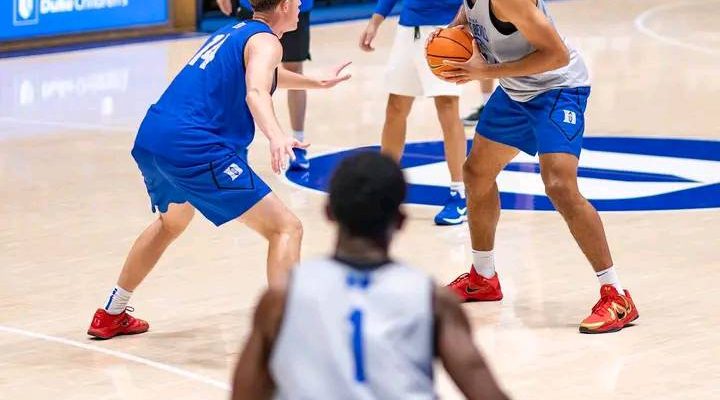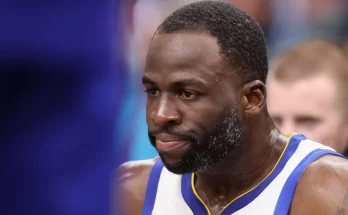It starts with a clip—just a few seconds of warmups, of drills, of bodies darting across the floor, voices echoing, sweat flying. But in that clip you see a transformation, a shift: this isn’t Duke the past few seasons. This is Duke under Jon Scheyer, and already fans are whispering that something is different—more energy, more swagger, more edge. There is even a rumble of fights. The buzz is real, and this team looks like it’s trying to grow a spine.
From the first cut, it’s clear Scheyer is pushing harder. Gone is the soft approach many critics accused him of early in his tenure. The practices now feel sharper, more deliberate. He’s mic’d up, barking at players, demanding defense, emphasizing accountability. During one media day practice, you could hear him exhorting the team: defense first, talk, effort, make every possession matter. ) The tone is unmistakable. A season ago, there were murmurs that Duke sometimes lacked fire; those murmurs are being drowned out now.
One of the most striking reports is how summer practices have become proving grounds. There is less deference to returners, less room for entitlement. At times, according to insiders, the veterans looked rattled when new faces brought intensity and attitude from day one. In one media account, Cameron Boozer is said to have “taken practice over” on arrival, pushing tempo, demanding a tone that left even experienced players scrambling to match itThat’s not just a shift in rotation — that’s a shift in hierarchy, mindset, who gets to set the standard.
Fans on message boards and social media are amplifying it. Some are elated, seeing in the snippets of video a team embracing conflict, a team ready to scrap. Others are cautious, asking whether intensity will translate to discipline or if ego battles will fracture cohesion. The contrast to prior seasons is a frequent talking point: this team, they say, already “feels different.”
Where in past years you might detect softness—easy possessions given up, apathetic closeouts, lapses in effort—those seem to be fading. Scheyer isn’t letting mistakes slide. One observer described a clip where a returning guard missed a lob to Khaman Maluach; Scheyer immediately whistled, snarled “He’s open!” “Lob!” even dropped an expletive to drive home the pointThat kind of vocal accountability wasn’t always present in earlier seasons.
And then there are the scraps. In a high level sport, bodies bump, tempers flare. But in this new Duke, a few mini-fights have broken out in practice—guards chirping at each other, post players pushing through screens, contested rebounds sparking shoves. These aren’t crazed assaults, but sparks. But sparks matter: they show emotion, willingness to fight for every possession, intolerance for being outworked. At this level, those margins can make the difference between close wins and close losses.
A lot depends on how Scheyer handles it—if he allows raw intensity to tip into discord, or channels it into cohesion. But early signs suggest he sees the benefit. At media day, he spoke repeatedly about defense being the backbone, of preserving last season’s identity, but with more edge. He seems intent on turning talent into toughness.
Still, talent remains. The roster features high‑profile freshmen and transfers: names with reputations of production and competitiveness. Scheyer and staff seem to have targeted players not just for their skill, but for their desire to earn roles, to compete.In practice, those new arrivals are carrying weight early, matching against veterans, pushing pace, inviting confrontation. The message: no role is safe; everyone must fight.
Some returners reportedly reacted poorly—caught off guard when their status didn’t guarantee deference, when they were challenged both physically and verbally. But that may be precisely what Scheyer intends. The program needs renewed hunger. Those unwilling to compete risk being edged out. Observers say you can feel a tension now that was absent before, in a way that makes you believe something is evolving.
The talking point among fans: maybe Scheyer is learning, growing into his role not just as recruiter or tactician, but as enforcer of culture. The old Scheyer was likeable, calm, trusting; the new one seems more forceful, more willing to push back, more willing to demand. That evolution, many hope, will produce a more resilient, more dangerous Duke.
There are already signs of belief opening in fan circles. Clips of practice, posted by the media team or leaked, get shared with comments like “this is the Duke we should’ve seen” or “they look mean now.” Some say they see swagger in how players move, how they challenge each other, how they communicate. Others, still suspicious, warn this could backfire—that egos might collide, breaks might be exploited, discipline lost.
But there is room for optimism. A culture of accountability, if done right, can force a group to raise its floor. If the fight stays internal rather than destructive, if conflict channels into growth, this could be the bedrock for a new identity—one that combines Duke’s historic standards with modern hunger. Rather than relying solely on talent and reputation, this Duke wants to assert itself physically and mentally.
Already, perceptions are shifting. Some prominent commentators and insiders now talk about this Duke team not as “just another blue blood,” but as a team with bite, with a mean streak, one that wants to impose itself. The weight of Duke’s tradition remains heavy, but the hull is being reinforced with steel. In decades past, teams would exploit Duke’s softness; now the table seems turning.
Still, it’s early. Practice intensity is not the same as game toughness. Many teams look combative in March but crumble under pressure. The true test comes when the season begins, when challenges multiply—road games, hostile crowds, injuries, adversity. Will this heightened culture hold under strain, or collapse when things are difficult? Will players internalize it or resist it? Will the balance between structure and freedom tilt the wrong way?
If all goes well, this Duke could be better built to defend, to fight, to absorb adversity. The swagger and edge we’re seeing may evolve into real distance-making capability, especially when they need it most. But if mismanaged, it could lead to internal fracture, frustration, inconsistency.
That said, the initial reaction is electric. In a sport where culture and identity often distinguish good teams from great ones, Duke seems to be carving out a new one. The fans are buzzing because they sense they’re watching a rebirth—not just of roster or scheme, but of attitude. The expectation is no longer just to be excellent, but to be unyielding. The prancing silk of prior eras is giving way to something tougher.
Yesterday’s weaknesses—motivation, effort, mental lapses—are being targeted. Every possession in practice looks contested. Every drill is a chance to prove toughness, not just skill. The intensity could be the spine this team lacked. If this is real, if it holds, we may look back at these practice videos as the first glimpses of a transformation. Duke fans are talking not about how this roster compares, but about how this mindset feels different.
So yes—energy, swagger, even a few fights. Maybe it’s theater, maybe it’s real. But the signal is clear: Duke under Jon Scheyer is trying to push, to grow, to demand more—not just from its opponents, but from itself. And if that translation from practice to performance holds, this Duke could surprise a lot of people.



